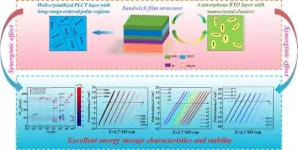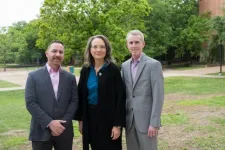As a green, sustainable, and competitive technology relative to batteries and electrochemical capacitors and featuring a high charge storage capability, the dielectric capacitors excel in low cost, long cycle-life, and a broad operating temperature range, as well as environmental friendliness, high security, and good reliability. Most importantly, they top other technologies in terms of ultra-high-power density due to their unrivaled charge-discharge speed. These features have created a number of applications for them in power electronic devices and pulsed power equipment. Among the dielectric capacitors, the ferroelectric ones can provide a high energy density due to large electric polarization, thereby receiving an increasing amount of great attention.
Recently, a team of material scientists led by Jun Ouyang and Hanfei Zhu from Qilu University of Technology in Jinan, China reported an effective strategy that aimed to achieve synchronous improvements in energy storage density, efficiency, and stability of ferroelectric capacitors by constructing a simple tri-layer film heterostructure in which a well-crystallized ferroelectric layer was sandwiched by two pseudo-linear dielectric layers with a dominant amorphous microstructure, which can become a generally effective pathway to enhance the energy storage performances of ferroelectrics capacitors working in various harsh environments.
The team published their work in Journal of Advanced Ceramic on January 2, 2024.
“In this report, we propose a strategy to boost the energy storage performances and stabilities of ferroelectric capacitors simultaneously by constructing a tri-layer film in which a well-crystallized ferroelectric layer was sandwiched by two pseudo-linear dielectric layers with a dominant amorphous structure. We successfully implemented this design strategy in the sol-gel-derived BaTiO3/(Pb,La,Ca)TiO3/BaTiO3 tri-layer films via a rapid thermal annealing. This sandwiched film is endowed with a large energy density Wrec (~80 J/cm3) and a high efficiencyh (~86%), especially an outstanding cycling stability that can withstand 109 electric cycles. This innovative work will pave the way for the utilization of sandwiched ferroelectric films in applications of electric power systems and advanced pulsed-discharge devices.” said Hanfei Zhu, an associate professor at the School of Chemistry and Chemical Engineering at Qilu University of Technology (China), and one young expert whose research interests focus on the field of ferroelectric and multiferroic materials.
“In contrast to the electrochemical energy-storage systems, the low energy density of dielectric capacitors is a fatal application bottleneck, especially in miniaturized devices and integrated systems,” Hanfei Zhu said.
The ferroelectric film capacitors have shown great potential in providing a high energy density due to their large electric polarizations. Nevertheless, a trade-off, usually a negative correlation, between the polarization (P) and the breakdown strength (Eb) and the more easily produced loss of ferroelectric films severely limit the further increase in energy density and efficiency. And beyond that, the film capacitors are vulnerable to potential damages caused by the changes in circuit temperature, working frequency, and load rate. “So how to break or mitigate the couplings between polarization, breakdown strength and loss by efforts so as to improve the energy storage performances and the stabilities in a broad temperature, frequency, and cycling time has become a challenge for the ferroelectric film capacitors,” said Hanfei Zhu.
To address these above issues, Zhu’s team proposed an effective strategy that aimed to achieve synchronous improvements in energy storage density, efficiency, and stability of ferroelectric film capacitors by constructing a simple tri-layer film structure in which a well-crystallized ferroelectric layer was sandwiched by two pseudo-linear dielectric layers with a dominant amorphous microstructure. The research team provided a paradigm of sandwich BaTiO3/(Pb,La,Ca)TiO3/BaTiO3 thin film fabricated on Pt-coated Si substrate via a low-cost sol-gel method combining with a rapid thermal annealing (RTA) process. The fully crystallized PLCT layer in sandwich film and the amorphous BTO layer with some independently-distributed nanocrystal clusters (NCs) work together to create a large energy density Wrec (~80 J/cm3) and a high efficiency h (~86%), especially its much-improved energy storage stabilities against a varying temperature (25–150 ℃), frequency (20 Hz–10 kHz) and charge-discharge cycle (up to 109 cycles). “Our work shows that the sandwich thin films by co-designing nanocrystal-dispersed amorphous and fully-crystallized phase structures can become a generally effective pathway to enhance the energy storage performances of ferroelectrics capacitors working in harsh environments,” Hanfei Zhu said.
Other contributors to this work include J. Liu, Y. Wang, H. Luo, C. Liu and H. Cheng from the School of Chemistry and Chemical Engineering at Qilu University of Technology in Jinan, China; X. Zhai from the School of Physics at Shandong University in Jinan, China; Y. Huan from the School of Materials Science and Engineering at Jinan University in Jinan, China; J. Yan from the College of Physics and Electronic Engineering at Qilu Normal University in Jinan, China; and K. Wang from the China Tobacco Shandong Industrial Co., Ltd. in Jinan, China.
This work was supported by the National Natural Science Foundation of China (NSFC) (Grant Nos. 52002192, 51772175, and 52072150), the Natural Science Foundation of Shandong Province (Grant Nos. ZR2020QE042, ZR2022ZD39, ZR2022ME031, ZR2022ME075, ZR2022QB138), and the Science, Education and Industry Integration Pilot Projects of Qilu University of Technology (Shandong Academy of Sciences) (Grant Nos. 2022PY055, 2022GH018). The authors also acknowledge the support from the Jinan City Science and Technology Bureau (Grant No. 2021GXRC055).
About the Author
Dr. Hanfei Zhu is an associate professor in the School of Chemistry and Chemical Engineering, Qilu University of Technology, China. He achieved his Master degree in Condensed Physics from Harbin University of Science and Technology in 2013, and received his Ph.D degree in Material Science and Engineering from Shandong University in 2017. In the same year, he joined Qilu University of Technology. His research interests are focusing on piezoelectric, ferroelectric and multiferroic materials, as well as dielectric materials for energy storage applications, including Pb(Zr,Ti)O3, BaTiO3, BiFeO3. Until now, he has published more than 30 peer reviewed journal papers and owns 5 invention patents. For more information, please pay attention to his research homepage https://hgxy.qlu.edu.cn/zhf/list.htm.
About Journal of Advanced Ceramics
Journal of Advanced Ceramics (JAC) is an international journal that presents the state-of-the-art results of theoretical and experimental studies on the processing, structure, and properties of advanced ceramics and ceramic-based composites. JAC is Fully Open Access, monthly published by Tsinghua University Press on behalf of the State Key Laboratory of New Ceramics and Fine Processing (Tsinghua University) and the Advanced Ceramics Division of the Chinese Ceramic Society, and exclusively available via SciOpen. JAC has been indexed in SCIE (IF = 16.9, top 1/28, Q1), Scopus, and Ei Compendex.
About SciOpen
SciOpen is a professional open access resource for discovery of scientific and technical content published by the Tsinghua University Press and its publishing partners, providing the scholarly publishing community with innovative technology and market-leading capabilities. SciOpen provides end-to-end services across manuscript submission, peer review, content hosting, analytics, and identity management and expert advice to ensure each journal’s development by offering a range of options across all functions as Journal Layout, Production Services, Editorial Services, Marketing and Promotions, Online Functionality, etc. By digitalizing the publishing process, SciOpen widens the reach, deepens the impact, and accelerates the exchange of ideas.
END






